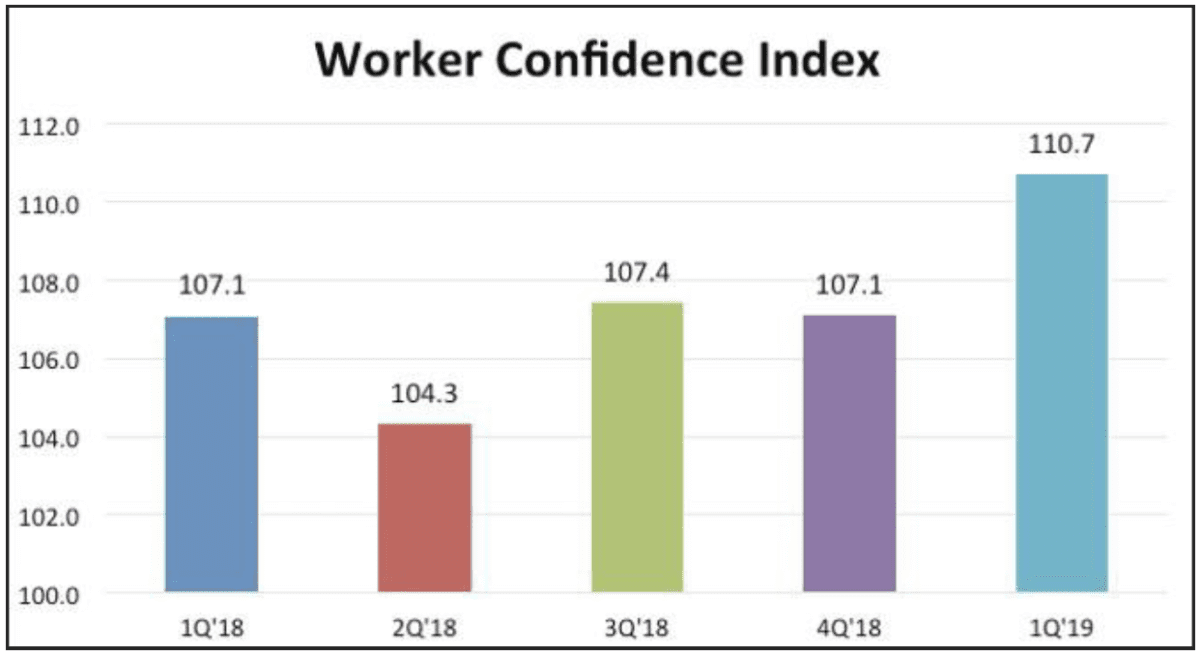Workers believe promotions and raises are coming their way.
By Larry Basinait
The Worker Confidence Index (WCI) for the first quarter of 2019 increased by 3.6 points to 110.7, the highest level since this study’s inception. The four indices that comprise the worker confidence index reported mixed results in the fourth quarter of 2018. The job security and likelihood of a raise indices both increased for the quarter, while the likelihood of a promotion and trust in company leadership both declined. For the year, three of the four indices were higher, with only trust in company leadership in decline.
The four indices that comprise the WCI reported largely positive results in the first quarter. The job security index was the only index to report a quarterly decrease, while the likelihood of a promotion, the likelihood of a raise, and trust in company leadership indices all increased. On a year-over-year basis, all four indices increased for only the third time in study history.
Worker confidence in job stability remains high. In the first quarter of 2019, the job security index dropped by 2.6 points to 102.6, which is close to the study average of 102.8. Despite the modest decline, confidence remains high. Concern about job loss is the most important indicator in estimating worker confidence about their current and near-term financial outlook.
Females reported increasingly higher levels of confidence in their job security than males again in the first quarter, which continues as a trend. Women historically report less fear of job loss than males. The percentage of males who felt that they would lose their job increased in the first quarter of 2019 to 12.9 percent from 10.3 percent in the prior quarter, which drove the overall decline in the job security index.
Worker perceptions about the likelihood of a raise increased by 5.7 points to 113.3 -an all-time record. Both males and females continued to feel more confident about getting a raise, as 36.5 percent of males and 25.8 percent of females anticipated a raise of at least 3 percent at their next review. In terms of age, study findings once again show in the first quarter of 2019 that as employees get older, more and more feel that what they make today is what they will make tomorrow. Workers between 55 and 64 years of age largely feel their wages have stagnated, as 79 percent don’t anticipate a substantial raise -although this is the most confident they have felt since the inception of the study.
The belief in the likelihood of a promotion also rose to an all-time high in the first quarter to 121.2. This is an increase of 8.5 points from last quarter, with males feeling a promotion is more likely than females, a trend that has happened every quarter of the study. Respondents with annual incomes of more than $100,000 felt the most optimistic about the likelihood of promotion, with 29.1 percent believing a promotion was likely. This group has the most disposable income, which directly impacts the GDP.
Trust in company leadership increased in the first quarter of 2019, and now stands at 105.6. According to the 2019 Edelman Trust Barometer, the credibility of CEOs increased by 2 percentage points in 2019 to 47 percent. This aligns with the finding in the trust in company leadership Index.
Looking forward, what will be the impact on the turbulent stock market? The first quarter of 2019 was an exceptional quarter for stocks in the U.S. January returns saw the largest single monthly increase since October of 2015. In the first quarter of 2019, the S&P 500 rose 13.7 percent, the Dow Jones increased 11.15 percent, and the Nasdaq Composite increased 16.5 percent. All three indices have seen quarterly increases -that has not been the case in a few years. According to MSN Money, the S&P 500 had its best quarter since the third quarter of 2009, while the Dow Jones had its best start to the year since 2013, and the Nasdaq Composite had its best quarter since the first quarter of 2012.
For more information from this quarter’s WCI, click here.















